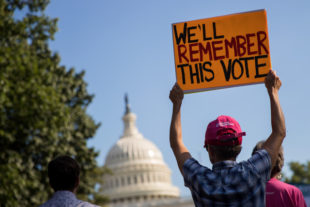Georgia’s uninsured rate fell to 12.9 percent in 2016 from 13.9 percent the previous year, according to the U.S. Census Bureau.
But the number and percentage of Georgians without health coverage remains among the highest in the nation. Its uninsured rate trails only Texas, Alaska and Oklahoma.

Nationally, the number of Americans without health insurance fell to 28.1 million in 2016, down from 29 million in 2015, said the report, released Tuesday.
The latest numbers from the Census Bureau showed the nation’s uninsured rate dropped to 8.8 percent from 9.1 percent in 2015. Both the overall national number of uninsured and the percentage are record lows.
Bill Custer, a health insurance expert at Georgia State University, linked the gains in health insurance nationally to rising incomes and lower poverty rates defined in the report.
The Census Bureau said real median household income increased by 3.2 percent between 2015 and 2016, while the official poverty rate decreased 0.8 percentage points.
In terms of health insurance, 2016 “was pretty much of a status quo year, compared with other years,’’ Custer said Wednesday.

The states that have expanded Medicaid under the Affordable Care Act have lower rates of uninsured people, he noted. Georgia is one of 19 states that have rejected expansion, with state political leaders citing the costs involved with the move.
Custer said the uninsured rate for 2016 does not reflect the instability currently afflicting the insurance exchanges, which were created by the ACA to help people without job-based or government health plans buy coverage.
The White House has not guaranteed the 2018 subsidies to insurers that reduce out-of-pocket costs for lower-income consumers in the exchanges. And the administration has made large cuts to marketing and enrollment activities for the 2018 exchange year.
“The problem is that moving forward, we don’t know what will happen,’’ Custer said. “The fear is that [the 2016 uninsured rates] are not a true representation of what’s happening now.”
This year, Republican efforts to repeal the ACA, also known as Obamacare, have failed. But some Democrats, though opposed to repeal, acknowledge flaws in the health law. Now a bipartisan effort is under way in a Senate committee to “repair” the ACA without repealing it.

The effort is being led by the health committee chairman, Sen. Lamar Alexander (R-Tenn.). The goal is to stabilize the Obamacare individual insurance market by protecting its “cost-sharing subsidies.”
The Commonwealth Fund noted that uninsured rates declined across all age groups in 2016, with the greatest gains among young adults. The uninsured rate among adults ages 19 to 25 dropped by 1.4 percentage points in 2016 to 13.1 percent, the largest one-year drop of any age group.
But there were sharp differences in the percentage of people uninsured at different ages, “reflecting the fragmented nature of the U.S. health insurance system,’’ the Commonwealth Fund report said.
For example, 26-year-olds have the highest uninsured rate of any age, at 17.5 percent.
This dropoff in coverage at age 26 likely reflects adult children aging off their parents’ insurance policies and experiencing some time without insurance. The ACA allows children to remain on their parents’ health plans till age 26.
Latinos continue to be the most likely of racial and ethnic groups to lack health insurance.

In 2016, non-Hispanic Whites had the lowest uninsured rate among race and Hispanic origin groups, at 6.3 percent. The uninsured rates for Blacks and Asians were higher than for non-Hispanic Whites, at 10.5 percent and 7.6 percent, respectively.
Hispanics had the highest uninsured rate, at 16 percent.

